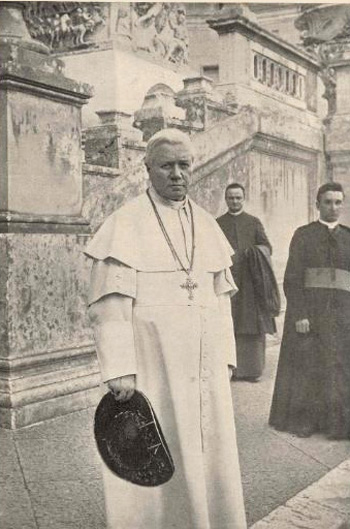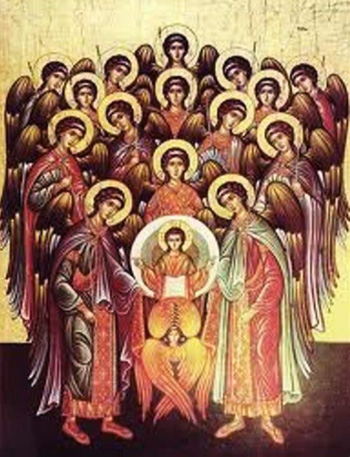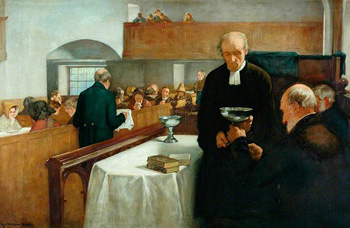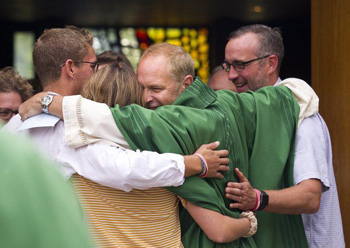Problemas Tradicionalistas
 |
 |
 |
 |
 |
 |
 |
Misa de Diálogo - CXI
La Dignidad de la Adoración
Recordemos que el Papa Pío X dio prioridad a prever la “santidad y dignidad del templo” como telón de fondo adecuado para las ceremonias a través de las cuales se representan los santos misterios. (1) El P. Bacuez dedicó una sección completa de su libro a describir el papel fundamental de las Órdenes Menores y el Subdiaconado que contribuyeron sustancialmente a “la adoración de Dios de una manera digna de Su majestad”. (2) Sin ellos, ¿cómo sería la liturgia?
 “Las ceremonias del culto divino serían menos imponentes si no hubiera variedad en rango y función entre los ministros del santuario. Representarían de manera mucho menos perfecta la religión de las jerarquías celestiales y el culto incesantemente tributado a Dios por los diferentes órdenes de la creación”. (3)
“Las ceremonias del culto divino serían menos imponentes si no hubiera variedad en rango y función entre los ministros del santuario. Representarían de manera mucho menos perfecta la religión de las jerarquías celestiales y el culto incesantemente tributado a Dios por los diferentes órdenes de la creación”. (3)
Armados con esta información de una fuente genuinamente tradicional, podemos ver los efectos de la pérdida de las Órdenes Menores en la liturgia del Novus Ordo. Sin las ordenaciones secuenciales a través de los grados del ministerio de la Iglesia, las jerarquías de los cargos no están claramente delineadas; se deteriora la “verticalidad” del culto dirigido a Dios; todos los ministros (incluido el obispo) están de pie o sentados al mismo nivel; la distinción entre el clero y los laicos se difumina, y las mujeres compiten con los hombres en el santuario para desempeñar los oficios litúrgicos. Poco en el camino de la diferenciación (4) es evidente en la nueva liturgia, para reflejar la diferencia entre lo sagrado y lo profano, o incluso entre Dios y el hombre. Por lo tanto, no sorprende que no refleje ni las "jerarquías celestiales" ni el orden creado del mundo.
Padre Bacuez explicó además:
“Para ser digno de Dios y provechoso para los fieles, este culto debe tener cierta solemnidad, hablar tanto a la mente como al corazón, y estar calculado para despertar en las almas sentimientos santos y sentimientos piadosos.
“Ahora bien, ¿se producirían estos efectos si hubiera un solo Orden de ministros y una sola función a realizar? Con la desaparición de los numerosos ministros oficiantes y de las diversas ceremonias desaparecería en gran medida también el imponente espectáculo de los misterios divinos, sus significados simbólicos, los vestigios del antiguo culto, los recuerdos de la historia de Nuestro Salvador, las anticipaciones de la liturgia celestial, las expresiones edificantes de la caridad, el respeto mutuo, la deferencia y la subordinación, que los ministros del santuario, en sus relaciones mutuas, ponen incesantemente ante los ojos de los fieles”. (5)
 Todos estos bienes del Rito Romano contienen en sí mismos la justificación de su permanencia en la Iglesia. También proporcionan las bases para la conservación de las Órdenes Menores y del Subdiaconado que las sostienen y las vivifican. Por la misma lógica, sólo alguien con un deseo de muerte por la verdad y el esplendor de la liturgia romana podría haber concebido la eliminación del orden católico en el santuario.
Todos estos bienes del Rito Romano contienen en sí mismos la justificación de su permanencia en la Iglesia. También proporcionan las bases para la conservación de las Órdenes Menores y del Subdiaconado que las sostienen y las vivifican. Por la misma lógica, sólo alguien con un deseo de muerte por la verdad y el esplendor de la liturgia romana podría haber concebido la eliminación del orden católico en el santuario.
Padre Bacuez describió, con precisión profética, las consecuencias negativas que se producirían si la Iglesia violara su deber de recibir y transmitir la tradición de las Órdenes Menores:
“Los servicios estarían marcados sólo por su frialdad y monotonía, y se diría de los católicos lo que a menudo se dice de los protestantes, que no tienen más que una religión abstracta, sin forma, incapaz de apelar a las facultades emocionales, y poco en armonía. con los sentimientos de la mayoría de la raza humana”. (6)
Aunque pocas personas estaban familiarizadas con la expresión técnica lex orandi lex credendi, la mayoría era consciente de la conexión entre adoración y creencia, y cómo la primera influye y da forma a la segunda. Padre Bacuez expresaba este axioma en términos prácticos: quitad las imponentes estructuras del Rito Romano (en este caso las Órdenes Menores y el Subdiaconado) y nos quedaríamos con una liturgia banal, racionalista y fría en el sentido de que no logra inspirar devoción y mantener viva la llama de la Fe.
 La naturaleza profética de estas palabras es sorprendente, ya que eso es exactamente lo que sucedió cuando se impuso la liturgia simplificada y racionalizada de la Misa Novus Ordo, que el p. Bacuez insinuaba que la Misa católica tradicional tiene un atractivo del que carecen los servicios de las religiones protestantes porque, en el fondo, el alma humana necesita el sentido de misterio que se encuentra en el rico simbolismo de la liturgia tradicional para atraerla hacia arriba y encontrar lo Divino.
La naturaleza profética de estas palabras es sorprendente, ya que eso es exactamente lo que sucedió cuando se impuso la liturgia simplificada y racionalizada de la Misa Novus Ordo, que el p. Bacuez insinuaba que la Misa católica tradicional tiene un atractivo del que carecen los servicios de las religiones protestantes porque, en el fondo, el alma humana necesita el sentido de misterio que se encuentra en el rico simbolismo de la liturgia tradicional para atraerla hacia arriba y encontrar lo Divino.
Y, sin embargo, los creadores del Novus Ordo eliminaron deliberadamente de la liturgia la mayor cantidad posible de simbolismo claramente católico, siguiendo el ejemplo de los protestantes del siglo XVI y los líderes del Movimiento de la liturgia., quienes buscaban amortiguar la expresión externa de la devoción religiosa.
Un 'espectador tonto'
En las décadas previas al Concilio Vaticano II, los fieles eran constantemente reprendidos por los líderes de la Iglesia (incluidos los Papas) por ser lo que denominaban “espectadores mudos” durante la Misa, como si su oración silenciosa fuera una enfermedad para la cual la “participación activa” fuera la cura. Pero lo que los reformadores no supieron apreciar fue que, al mirar la acción que se desarrolla en el santuario, los fieles se sumergen en los misterios sagrados, porque la liturgia católica habla al alma a través de los sentidos, particularmente el de la vista. El Padre Bacuez capturó esta verdad, reconocida por todas las generaciones de fieles católicos antes de que el Movimiento Litúrgico alterara la percepción de la mayoría:
“Ella [la Iglesia] ama hablar a los ojos por su culto, sus ritos, sus solemnidades, su jerarquía; y en sus santuarios, como en la naturaleza, todo está lleno de sentido Nihil est sine voce. (I Cor. 14: 10) Con la Iglesia, con Nuestro Salvador, no hay un acto que no tenga un cierto significado, indicativo de algún plan o de alguna operación oculta.” (7)
Su énfasis principal aquí fue, por supuesto, en las Órdenes Menores y el Subdiaconado, y cómo muestran la naturaleza jerárquica de la Iglesia a todos los espectadores. Por el contrario, es difícil discernir la naturaleza particular de las órdenes clericales restantes en la liturgia del Novus Ordo debido a su reducción en número (solo hay una orden clerical por debajo del sacerdocio en lugar de las seis tradicionales), su identidad alterada y la mezcla de participantes laicos en el santuario que desempeñan los mismos roles.
La promoción deliberada de la ignorancia
Esto, ahora sabemos, fue un acto deliberado de ofuscación por parte de liturgistas progresistas que habían estado trabajando duro en comisiones y comités para confundir y nublar la verdad sobre la Constitución jerárquica de la Iglesia como lo quiso su Fundador: su naturaleza monárquica ya no se proclama abiertamente ni se demuestra en los nuevos ritos. Claramente, los responsables de las reformas tenían sus propias razones para que los fieles “no supieran”.
Una experiencia que cambia la fe para los sacerdotes y fieles del Novus Ordo
 La locura de suprimir todas las órdenes clericales por debajo del diaconado es evidente en la opinión, que ahora prevalece entre la mayoría, si no todos, los católicos posteriores al Vaticano II, de que todos los miembros de la Iglesia, tanto clericales como laicos, son igualmente responsables para llevar a cabo su misión en el mundo. Derribar al sacerdote de su pedestal supuso una ruptura con las viejas creencias sobre el verdadero significado del sacerdocio católico, que sería sustituido por una genérica “participación activa” de todos en la misión de la Iglesia.
La locura de suprimir todas las órdenes clericales por debajo del diaconado es evidente en la opinión, que ahora prevalece entre la mayoría, si no todos, los católicos posteriores al Vaticano II, de que todos los miembros de la Iglesia, tanto clericales como laicos, son igualmente responsables para llevar a cabo su misión en el mundo. Derribar al sacerdote de su pedestal supuso una ruptura con las viejas creencias sobre el verdadero significado del sacerdocio católico, que sería sustituido por una genérica “participación activa” de todos en la misión de la Iglesia.
Con el nuevo énfasis en todo el Pueblo de Dios como agente activo en la edificación del Reino de Dios mediante el ejercicio de sus dones y “carismas” individuales, las Órdenes Menores se hicieron redundantes. Del mismo modo, los candidatos a la ordenación perderían el sentido de su primera vocación que es el culto a Dios, y los sacerdotes su condición única de ministros de la Palabra y de la Eucaristía.
El bautismo visto, como la muerte, como el gran nivelador (8)
Según una declaración de 2019 de la Conferencia de Obispos de EE. UU., el bautismo, no la ordenación, es “la base de cómo concebimos a la Iglesia”.
“Nuestro enfoque al pensar en la Iglesia, y al celebrar su realidad, debe estar en la unidad del pueblo de Dios que se basa en nuestro bautismo común, y en la comprensión correspondiente de la diversidad de roles y carismas dentro de ese pueblo radicalmente unificado”. (9)
Como resultado de este fermento revolucionario, la palabra “ministerio”, que alguna vez fue universalmente reconocible y que designaba los oficios de los ordenados, se redefinió radicalmente para cubrir la categoría “inclusiva” de todos los bautizados. Junto con la nueva narrativa "consciente del bautismo" (introducida por primera vez por Beauduin y Virgil Michel a principios del siglo XX) vino un recrudecimiento de las viejas ideas y creencias modernistas que animaron un nuevo marco eclesial para la construcción de lo que ahora conocemos como la “Iglesia sinodal” del Pueblo de Dios.
Continuará...

Pío X: Santidad y dignidad, prioridad en las ceremonias
Armados con esta información de una fuente genuinamente tradicional, podemos ver los efectos de la pérdida de las Órdenes Menores en la liturgia del Novus Ordo. Sin las ordenaciones secuenciales a través de los grados del ministerio de la Iglesia, las jerarquías de los cargos no están claramente delineadas; se deteriora la “verticalidad” del culto dirigido a Dios; todos los ministros (incluido el obispo) están de pie o sentados al mismo nivel; la distinción entre el clero y los laicos se difumina, y las mujeres compiten con los hombres en el santuario para desempeñar los oficios litúrgicos. Poco en el camino de la diferenciación (4) es evidente en la nueva liturgia, para reflejar la diferencia entre lo sagrado y lo profano, o incluso entre Dios y el hombre. Por lo tanto, no sorprende que no refleje ni las "jerarquías celestiales" ni el orden creado del mundo.
Padre Bacuez explicó además:
“Para ser digno de Dios y provechoso para los fieles, este culto debe tener cierta solemnidad, hablar tanto a la mente como al corazón, y estar calculado para despertar en las almas sentimientos santos y sentimientos piadosos.
“Ahora bien, ¿se producirían estos efectos si hubiera un solo Orden de ministros y una sola función a realizar? Con la desaparición de los numerosos ministros oficiantes y de las diversas ceremonias desaparecería en gran medida también el imponente espectáculo de los misterios divinos, sus significados simbólicos, los vestigios del antiguo culto, los recuerdos de la historia de Nuestro Salvador, las anticipaciones de la liturgia celestial, las expresiones edificantes de la caridad, el respeto mutuo, la deferencia y la subordinación, que los ministros del santuario, en sus relaciones mutuas, ponen incesantemente ante los ojos de los fieles”. (5)

La liturgia debe reflejar las jerarquías celestiales
Padre Bacuez describió, con precisión profética, las consecuencias negativas que se producirían si la Iglesia violara su deber de recibir y transmitir la tradición de las Órdenes Menores:
“Los servicios estarían marcados sólo por su frialdad y monotonía, y se diría de los católicos lo que a menudo se dice de los protestantes, que no tienen más que una religión abstracta, sin forma, incapaz de apelar a las facultades emocionales, y poco en armonía. con los sentimientos de la mayoría de la raza humana”. (6)
Aunque pocas personas estaban familiarizadas con la expresión técnica lex orandi lex credendi, la mayoría era consciente de la conexión entre adoración y creencia, y cómo la primera influye y da forma a la segunda. Padre Bacuez expresaba este axioma en términos prácticos: quitad las imponentes estructuras del Rito Romano (en este caso las Órdenes Menores y el Subdiaconado) y nos quedaríamos con una liturgia banal, racionalista y fría en el sentido de que no logra inspirar devoción y mantener viva la llama de la Fe.

La simplificación de la Misa Novus Ordo se acerca a la sequedad del culto protestante
Y, sin embargo, los creadores del Novus Ordo eliminaron deliberadamente de la liturgia la mayor cantidad posible de simbolismo claramente católico, siguiendo el ejemplo de los protestantes del siglo XVI y los líderes del Movimiento de la liturgia., quienes buscaban amortiguar la expresión externa de la devoción religiosa.
Un 'espectador tonto'
En las décadas previas al Concilio Vaticano II, los fieles eran constantemente reprendidos por los líderes de la Iglesia (incluidos los Papas) por ser lo que denominaban “espectadores mudos” durante la Misa, como si su oración silenciosa fuera una enfermedad para la cual la “participación activa” fuera la cura. Pero lo que los reformadores no supieron apreciar fue que, al mirar la acción que se desarrolla en el santuario, los fieles se sumergen en los misterios sagrados, porque la liturgia católica habla al alma a través de los sentidos, particularmente el de la vista. El Padre Bacuez capturó esta verdad, reconocida por todas las generaciones de fieles católicos antes de que el Movimiento Litúrgico alterara la percepción de la mayoría:
“Ella [la Iglesia] ama hablar a los ojos por su culto, sus ritos, sus solemnidades, su jerarquía; y en sus santuarios, como en la naturaleza, todo está lleno de sentido Nihil est sine voce. (I Cor. 14: 10) Con la Iglesia, con Nuestro Salvador, no hay un acto que no tenga un cierto significado, indicativo de algún plan o de alguna operación oculta.” (7)
Su énfasis principal aquí fue, por supuesto, en las Órdenes Menores y el Subdiaconado, y cómo muestran la naturaleza jerárquica de la Iglesia a todos los espectadores. Por el contrario, es difícil discernir la naturaleza particular de las órdenes clericales restantes en la liturgia del Novus Ordo debido a su reducción en número (solo hay una orden clerical por debajo del sacerdocio en lugar de las seis tradicionales), su identidad alterada y la mezcla de participantes laicos en el santuario que desempeñan los mismos roles.
La promoción deliberada de la ignorancia
Esto, ahora sabemos, fue un acto deliberado de ofuscación por parte de liturgistas progresistas que habían estado trabajando duro en comisiones y comités para confundir y nublar la verdad sobre la Constitución jerárquica de la Iglesia como lo quiso su Fundador: su naturaleza monárquica ya no se proclama abiertamente ni se demuestra en los nuevos ritos. Claramente, los responsables de las reformas tenían sus propias razones para que los fieles “no supieran”.
Una experiencia que cambia la fe para los sacerdotes y fieles del Novus Ordo

El sacerdote ahora es considerado al mismo nivel que los feligreses
Con el nuevo énfasis en todo el Pueblo de Dios como agente activo en la edificación del Reino de Dios mediante el ejercicio de sus dones y “carismas” individuales, las Órdenes Menores se hicieron redundantes. Del mismo modo, los candidatos a la ordenación perderían el sentido de su primera vocación que es el culto a Dios, y los sacerdotes su condición única de ministros de la Palabra y de la Eucaristía.
El bautismo visto, como la muerte, como el gran nivelador (8)
Según una declaración de 2019 de la Conferencia de Obispos de EE. UU., el bautismo, no la ordenación, es “la base de cómo concebimos a la Iglesia”.
“Nuestro enfoque al pensar en la Iglesia, y al celebrar su realidad, debe estar en la unidad del pueblo de Dios que se basa en nuestro bautismo común, y en la comprensión correspondiente de la diversidad de roles y carismas dentro de ese pueblo radicalmente unificado”. (9)
Como resultado de este fermento revolucionario, la palabra “ministerio”, que alguna vez fue universalmente reconocible y que designaba los oficios de los ordenados, se redefinió radicalmente para cubrir la categoría “inclusiva” de todos los bautizados. Junto con la nueva narrativa "consciente del bautismo" (introducida por primera vez por Beauduin y Virgil Michel a principios del siglo XX) vino un recrudecimiento de las viejas ideas y creencias modernistas que animaron un nuevo marco eclesial para la construcción de lo que ahora conocemos como la “Iglesia sinodal” del Pueblo de Dios.
Continuará...
- Papa Pío X, Tra le sollecitudini, 1903.
- Ibíd.., pág. 121.
- Ibíd., pág. 7.
- No hay rúbricas específicas para la colocación de la silla del obispo. Según el nuevo Ceremonial de Obispos, este podría ser en cualquier lugar del santuario, abriendo así la puerta a la opinión subjetiva. La Instrucción General del Misal Romano da una serie de opciones para la ubicación de la silla del sacerdote, pero insiste en que debe mirar hacia el pueblo, dando así la impresión de que desea ser considerado como uno de los congregación.
- Ibíd., pág. 134.
- Ibíd., págs. 134-135.
- Ibíd., pág. 138.
- “Omnia mors aequat” (la muerte nivela todo), de Claudian, De Raptu Proserpinae, libro II, línea 302.
- Monseñor Brian Bransfield, Secretario General, Conferencia de Obispos Católicos de los Estados Unidos, 'Vocación y Misión', 29 de mayo de 2019.
Publicado el 14 de febrero de 2022
______________________
______________________
 Volume I |
 Volume II |
 Volume III |
 Volume IV |
 Volume V |
 Volume VI |
 Volume VII |
 Volume VIII |
 Volume IX |
 Volume X |
 Volume XI |
 Special Edition |



